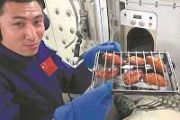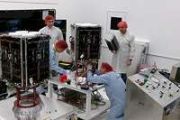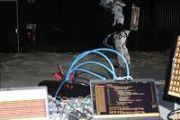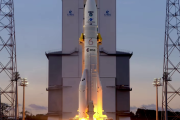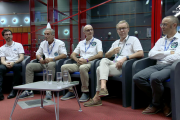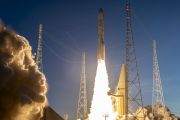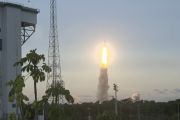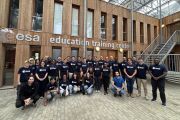
Copernical Team
How to catch a perfect wave: scientists take a closer look inside the perfect fluid
 Scientists have reported new clues to solving a cosmic conundrum: How the quark-gluon plasma - nature's perfect fluid - evolved into matter.
A few millionths of a second after the Big Bang, the early universe took on a strange new state: a subatomic soup called the quark-gluon plasma.
And just 15 years ago, an international team including researchers from the Relativistic Nuclear Col
Scientists have reported new clues to solving a cosmic conundrum: How the quark-gluon plasma - nature's perfect fluid - evolved into matter.
A few millionths of a second after the Big Bang, the early universe took on a strange new state: a subatomic soup called the quark-gluon plasma.
And just 15 years ago, an international team including researchers from the Relativistic Nuclear Col Guardians begin migration to Space Force CACs
 Space Force common access cards are being issued incrementally to Guardians after more than 18 months of collaboration across numerous organizations and five months of live testing with Guardians.
To produce a functioning USSF card, system and data owners across multiple agencies to include Air Force Personnel Center and the Defense Manpower Data Center, made critical systems changes to di
Space Force common access cards are being issued incrementally to Guardians after more than 18 months of collaboration across numerous organizations and five months of live testing with Guardians.
To produce a functioning USSF card, system and data owners across multiple agencies to include Air Force Personnel Center and the Defense Manpower Data Center, made critical systems changes to di China's cargo craft docks with space station core module
 China's cargo spacecraft Tianzhou-3, carrying supplies for the upcoming Shenzhou-13 crewed mission, successfully docked with the space station core module Tianhe on Monday, according to the China Manned Space Agency (CMSA).
At 10:08 p.m. (Beijing Time), Tianzhou-3 completed a computer-orchestrated rendezvous and docking at the rear docking port of the Tianhe core module. The whole process
China's cargo spacecraft Tianzhou-3, carrying supplies for the upcoming Shenzhou-13 crewed mission, successfully docked with the space station core module Tianhe on Monday, according to the China Manned Space Agency (CMSA).
At 10:08 p.m. (Beijing Time), Tianzhou-3 completed a computer-orchestrated rendezvous and docking at the rear docking port of the Tianhe core module. The whole process What's going on with the ozone?
 World governments agreed in the late 1980s to protect Earth's ozone layer by phasing out ozone-depleting substances emitted by human activities, under the Montreal Protocol. The phase out of these substances has not only helped protect the ozone layer for future generations but has also protected human health and ecosystems by limiting the harmful ultraviolet radiation from reaching Earth. On 16
World governments agreed in the late 1980s to protect Earth's ozone layer by phasing out ozone-depleting substances emitted by human activities, under the Montreal Protocol. The phase out of these substances has not only helped protect the ozone layer for future generations but has also protected human health and ecosystems by limiting the harmful ultraviolet radiation from reaching Earth. On 16 Nine ways AR and VR used on the International Space Station
 Even the most highly trained and experienced person sometimes needs a hand. For astronauts aboard the International Space Station, that helping hand comes from other crew members, experts on the ground, and increasingly, in the form of augmented reality (AR) and virtual reality (VR).
The first use of AR on station, a set of high-tech goggles called Sidekick, provided hands-free assistance
Even the most highly trained and experienced person sometimes needs a hand. For astronauts aboard the International Space Station, that helping hand comes from other crew members, experts on the ground, and increasingly, in the form of augmented reality (AR) and virtual reality (VR).
The first use of AR on station, a set of high-tech goggles called Sidekick, provided hands-free assistance Northrop Grumman's LEO satellite payload for DARPA revolutionizes positioning, navigation and timing
 The Defense Advanced Research Projects Agency (DARPA) Blackjack program has awarded Northrop Grumman Corporation (NYSE: NOC) a contract for Phase 2 development of an advanced, software-defined positioning, navigation and timing (PNT) payload, with options to build units destined for space flight.
The PNT payload work is led by Northrop Grumman's Future PNT Systems Operating Unit in Woodlan
The Defense Advanced Research Projects Agency (DARPA) Blackjack program has awarded Northrop Grumman Corporation (NYSE: NOC) a contract for Phase 2 development of an advanced, software-defined positioning, navigation and timing (PNT) payload, with options to build units destined for space flight.
The PNT payload work is led by Northrop Grumman's Future PNT Systems Operating Unit in Woodlan Solar electric propulsion makes Psyche spacecraft go
 When it comes time for NASA's Psyche spacecraft to power itself through deep space, it'll be more brain than brawn that does the work. Once the stuff of science fiction, the efficient and quiet power of electric propulsion will provide the force that propels the Psyche spacecraft all the way to the main asteroid belt between Mars and Jupiter. The orbiter's target: a metal-rich asteroid also call
When it comes time for NASA's Psyche spacecraft to power itself through deep space, it'll be more brain than brawn that does the work. Once the stuff of science fiction, the efficient and quiet power of electric propulsion will provide the force that propels the Psyche spacecraft all the way to the main asteroid belt between Mars and Jupiter. The orbiter's target: a metal-rich asteroid also call Telespazio selects Hughes HeloSat for Airborne Satellite Communications
 Hughes Network Systems reports that Telespazio, a joint venture between Leonardo (67%) and Thales (33%), has selected the Hughes HeloSat solution for satellite communications (SATCOM) for Leonardo's helicopters.
The solution combines the Hughes HM100 gateway and the HM400 modem for SATCOM on-the-move with technical support and systems integration. Once installed on helicopters like the Leo
Hughes Network Systems reports that Telespazio, a joint venture between Leonardo (67%) and Thales (33%), has selected the Hughes HeloSat solution for satellite communications (SATCOM) for Leonardo's helicopters.
The solution combines the Hughes HM100 gateway and the HM400 modem for SATCOM on-the-move with technical support and systems integration. Once installed on helicopters like the Leo NASA robots compete in DARPA's Subterranean Challenge Final
 Led by NASA JPL, Team CoSTAR will participate in the SubT final this week to demonstrate multi-robot autonomy in a series of tests in extreme environments.
Eight teams featuring dozens of robots from more than 30 institutions, including NASA's Jet Propulsion Laboratory in Southern California, will converge in a former Kentucky limestone mine from Sept. 21 to 24 to participate in a series o
Led by NASA JPL, Team CoSTAR will participate in the SubT final this week to demonstrate multi-robot autonomy in a series of tests in extreme environments.
Eight teams featuring dozens of robots from more than 30 institutions, including NASA's Jet Propulsion Laboratory in Southern California, will converge in a former Kentucky limestone mine from Sept. 21 to 24 to participate in a series o A new understanding of galaxy evolution with the Roman Space Telescope
 Galaxies change over time, but those changes take millions or billions of years - far longer than the human lifetime. To understand how galaxies evolve, astronomers therefore need to study large numbers of galaxies at various stages. NASA's Nancy Grace Roman Space Telescope will revolutionize galaxy studies since it can survey the sky up to thousands of times faster than can be done with Hubble
Galaxies change over time, but those changes take millions or billions of years - far longer than the human lifetime. To understand how galaxies evolve, astronomers therefore need to study large numbers of galaxies at various stages. NASA's Nancy Grace Roman Space Telescope will revolutionize galaxy studies since it can survey the sky up to thousands of times faster than can be done with Hubble 










